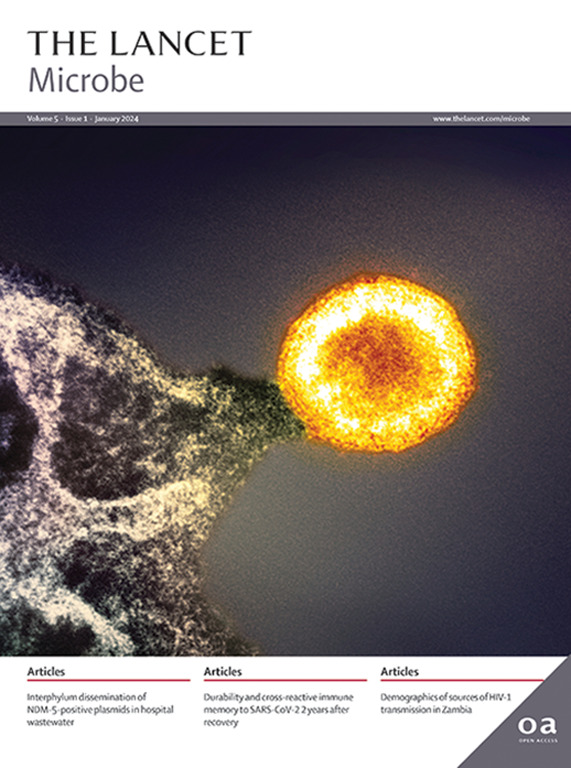Invasive Streptococcus dysgalactiae subspecies equisimilis compared with Streptococcus pyogenes in Australia, 2011–23, and the emergence of a multi-continent stG62647 lineage: a retrospective clinical and genomic epidemiology study
IF 20.4
1区 生物学
Q1 INFECTIOUS DISEASES
引用次数: 0
Abstract
Background
Streptococcus dysgalactiae subspecies equisimilis (SDSE) is closely related to Streptococcus pyogenes, with overlapping disease manifestations. We compared the clinical and genomic epidemiology of invasive SDSE with invasive S pyogenes across different settings in Australia and phylogenetically contextualised the SDSE sequences within a global cohort of genomes.
Methods
In this retrospective clinical and genomic epidemiology study, cases of invasive SDSE isolated from normally sterile sites were identified and whole-genome sequenced across five hospital networks in temperate southeast Australia (Melbourne and Sydney) and the tropical Top End of the Northern Territory. SDSE disease incidence, case demographics, clinical outcomes, and longitudinal lineage dynamics were compared between southeast Australia and the Top End and to co-collected invasive S pyogenes cases in each region. SDSE genomes and lineages were also contextualised within 1166 global SDSE sequences. Genomic transmission clusters (not necessarily direct transmission) were inferred between isolates from different individuals by single-linkage clustering at a single nucleotide polymorphism threshold of less than or equal to seven for SDSE and less than or equal to five for S pyogenes based on previous transmission analyses.
Findings
Between Jan 1, 2011, and Feb 28, 2023, there were 693 invasive SDSE cases and 995 invasive S pyogenes cases. Invasive SDSE occurred almost exclusively in adults. The overall invasive SDSE incidence in southeast Australia was similar to invasive S pyogenes (incidence rate ratio [IRR] 1·15, 95% CI 0·91–1·46; p=0·26) and increased over the study period (IRR 1·06 per year, 95% CI 1·05–1·08; p<0·0001) from 1·30 cases per 10 000 admissions in 2011 to 3·72 cases per 10 000 admissions in the first 2 months of 2023 (95% CI 2·13–6·07). In southeast Australia, where stringent COVID-19 non-pharmaceutical interventions (NPIs) were implemented between 2020 and 2021, the SDSE incidence plateaued during 2020–21 but did not significantly decline (IRR 1·09 compared with 2017–19, 95% CI 0·88–1·35; p=0·47). By contrast, S pyogenes incidence substantially declined in 2020–21 in southeast Australia (IRR 0·35 compared to 2017–19, 95% CI 0·22–0·52; p=0·017). In the Top End, SDSE incidence was lower than S pyogenes (IRR 0·24, 95% CI 0·19–0·31; p<0·0001). However, crude incidence remained higher than southeast Australia (crude IRR 1·24, 95% CI 1·07–1·42; p=0·0037) and disproportionately affected First Nations Australians in the Top End compared with non-First Nations individuals (IRR 3·36, 95% CI 2·33–4·85; p<0·0001). Comparing 2020–21 with 2017–19, there was no decline in SDSE (IRR 1·27, 95% CI 0·73–2·24; p=0·45) or S pyogenes (IRR 0·97, 95% CI 0·80–1·18; p=0·81) incidence in the Top End, which did not implement prolonged stringent COVID-19 NPIs. Analysing the available genomes of invasive cases and in lineages for which more than or equal to five invasive cases occurred, only 24 (6%) of 384 SDSE cases were assigned to genomic transmission clusters, compared with 271 (52%) of 524 S pyogenes cases. An stG62647 lineage encompassed 113 (26%) of 436 sequenced SDSE genomes. Analysis of available SDSE sequences from Australia, western Europe, and North America inferred concurrent international expansion of the stG62647 lineage in all three regions between 1990 and 2005.
Interpretation
We identified a substantial burden of invasive SDSE, dominated by the emergent stG62647 lineage. The contrasting epidemiology between species in the different Australian regions, during COVID-19 NPIs, and genomic infection patterns indicates transmission dynamic, pathogen population, and host–pathogen interaction differences between SDSE and S pyogenes and indicates implications for disease control measures.
Funding
Australian National Health and Medical Research Council.
2011-23年澳大利亚侵袭性失乳链球菌亚种equissimilis与化脓性链球菌的比较,以及多大陆stG62647谱系的出现:回顾性临床和基因组流行病学研究
背景:半乳糖不良链球菌(Streptococcus dysgalactiae, SDSE)与化脓性链球菌(Streptococcus pyogenes)关系密切,疾病表现重叠。我们比较了侵袭性SDSE和侵袭性化脓性S在澳大利亚不同地区的临床和基因组流行病学,并在全球基因组队列中对SDSE序列进行了系统发育背景分析。方法在这项回顾性临床和基因组流行病学研究中,研究人员在澳大利亚温带东南部(墨尔本和悉尼)和北领地热带顶端的五家医院网络中鉴定了从正常无菌部位分离的侵袭性SDSE病例,并对其进行了全基因组测序。比较澳大利亚东南部和Top End的SDSE发病率、病例人口统计学、临床结果和纵向谱系动态,并在每个地区共同收集侵袭性化脓性S病例。SDSE基因组和谱系也在1166个全球SDSE序列中进行了背景分析。基因组传播聚类(不一定是直接传播)在不同个体的分离株之间通过单链聚类推断出来,基于先前的传播分析,单核苷酸多态性阈值SDSE小于等于7,化脓性S小于等于5。结果2011年1月1日至2023年2月28日,侵袭性SDSE 693例,侵袭性化脓性S 995例。侵袭性SDSE几乎只发生在成人中。澳大利亚东南部的侵袭性SDSE总体发病率与侵袭性化脓S相似(发病率比[IRR] 1.15, 95% CI 0.91 - 1.46; p= 0.26),并在研究期间增加(IRR 1.06 /年,95% CI 1.05 - 1.08; p< 0.0001),从2011年的每1万入院患者1.30例增加到2023年前2个月的每1万入院患者3.72例(95% CI 2.13 - 6.07)。在澳大利亚东南部,在2020年至2021年期间实施了严格的COVID-19非药物干预措施(npi), 2020 - 21年期间SDSE发病率趋于平稳,但没有显著下降(IRR为1.09,与2017-19年相比,95% CI为0.88 - 1.35;p= 0.47)。相比之下,2020-21年,澳大利亚东南部的S化脓性致病菌发病率大幅下降(与2017-19年相比,IRR为0.35,95% CI为0.22 - 0.52;p= 0.017)。在Top End, SDSE的发病率低于S化脓性(IRR 0.24, 95% CI 0.19 - 0.31; p< 0.0001)。然而,粗发病率仍然高于澳大利亚东南部(粗IRR 1.24, 95% CI 1.07 - 1.42; p= 0.0037),并且与非原住民个体相比,高端原住民个体的发病率不成比例(IRR 3.36, 95% CI 2.33 - 3.85; p< 0.0001)。与2017-19年相比,未实施长期严格的COVID-19 npi的Top End的SDSE (IRR 1.27, 95% CI 0.73 - 2, p= 0.45)或S化脓性(IRR 0.97, 95% CI 0.80 -1, p= 0.81)发生率未下降。分析侵袭性病例和大于或等于5例侵袭性病例的谱系的可用基因组,384例SDSE病例中只有24例(6%)被分配到基因组传播集群,而524例S化脓性病例中有271例(52%)被分配到基因组传播集群。stG62647谱系包含436个测序的SDSE基因组中的113个(26%)。对澳大利亚、西欧和北美现有SDSE序列的分析推断,在1990年至2005年期间,这三个地区的stG62647谱系同时出现了国际扩张。研究人员发现了侵袭性SDSE的大量负担,主要是新兴的stG62647谱系。在2019冠状病毒病npi期间,澳大利亚不同地区物种之间的流行病学对比以及基因组感染模式表明SDSE和化脓S之间的传播动态、病原体种群和宿主-病原体相互作用差异,并表明疾病控制措施的意义。澳大利亚国家健康和医学研究委员会。
本文章由计算机程序翻译,如有差异,请以英文原文为准。
求助全文
约1分钟内获得全文
求助全文
来源期刊

Lancet Microbe
Multiple-
CiteScore
27.20
自引率
0.80%
发文量
278
审稿时长
6 weeks
期刊介绍:
The Lancet Microbe is a gold open access journal committed to publishing content relevant to clinical microbiologists worldwide, with a focus on studies that advance clinical understanding, challenge the status quo, and advocate change in health policy.
 求助内容:
求助内容: 应助结果提醒方式:
应助结果提醒方式:


